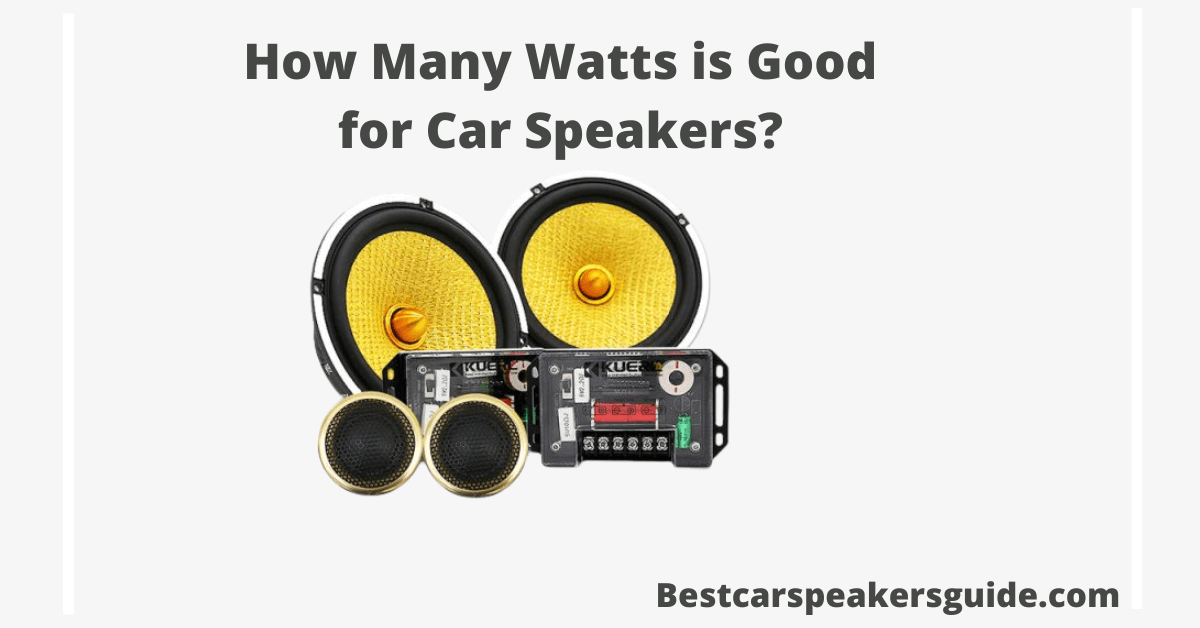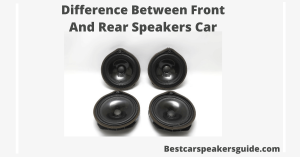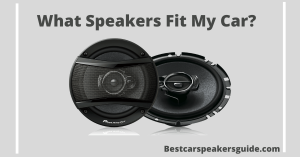Car stereos have become an essential feature of modern cars. Whether driving a sedan, convertible, or pickup truck, you need perfect speakers paired with the correct wattage. But how can you do that? How do you know how many watts are good for your car stereo?
Today we will answer all your questions about car speaker wattage, amplifiers, and more.
Car Speaker Watts Guide
Technically speaking, a watt is a unit used to measure power. The amount of energy a car speaker can process when producing sound. But we need to dig a little deeper to understand how wattage affects the audio experience.
1. Rated power
Power rating means the car stereo’s maximum capability is to handle power under certain circumstances. It’s important to note that this doesn’t necessarily indicate the amount of energy the stereo is processing.
If the car stereo is integrated into the amplifier, it handles 0 watts of power.
2. Speaker impedance
This parameter tells you how much resistance the speaker will draw without having to deal with much technology. We measure in ohms.
Evaluate speaker level inputs, watts RMS per channel, and help determine the maximum power of your car audio amplifier chip.
3. Sound Pressure Level
Perceived loudness is measured in Sound Pressure Level (SPL), and pressure determines the loudness of most speaker sound waves. Roughly, a 10dB increase in sound level doubles the volume but doubles the wattage. The result is a 3dB increase in SPL.
4. Understanding Amplifiers and Sound Systems
Put, an amplifier or amplifier serves to support the car stereo speakers. Their job is to take a low audio input and amplify it to be heard louder at a higher volume. Understanding the type of amplifier your car needs is significant as it will answer how much wattage your stereo uses.
All car stereos have built-in apps from the factory, but installing a custom amp can be a game changer. It will completely change the way stereo delivers sound. This is due to upgraded amp gas, better subwoofer setup, and original wiring.
4. Total Harmonic Distortion
We use this term to determine an audio system’s low sound pressure level. This is a situation where the RMS power performance is below par.
Total Harmonic Distortion (TDH) is the distortion that stereos face when producing a sound signal. On average, total or actual power is less than 0.1%. This is the result of less power.
5. Decibel
Decibel, abbreviated as dB, is a measure of sound intensity compared to a level on a logarithmic scale. Don’t be intimidated by extended definitions. Unlike a natural number, you cannot add two integers to a logarithmic scale.
Double does not mean twice on a logarithmic scale. Because 100 dB is logarithmic, it does not represent twice 50 dB. It is several times higher than 50 dB.
Wattage Required for Car Audio
Before improving your stereo amplifier or overall audio experience, it is essential to know what your stereo is already made of and how many watts your car stereo already has.
Analysis from the spec sheet shows that the average stereo wattage for a car should be around 8-10 watts RMS. The per-channel output of your car stereo or amplifier determines the volume of your sound system.
Car stereos have a power range of 8 to 30 watts. Most dual DIN stereos with 7″ screens average 15 watts of power, with the most powerful being 22 watts.
So how many Watts is good for car speakers?
There is no correct answer to this question. The amount of power required for a car stereo depends on several factors.
Type of car
External traffic noise can absorb much of the sound from your stereo. You’ll be okay with a relatively low wattage if you’re driving a sedan with rolled-up windows because you don’t have to turn up the volume too often.
On the other hand, driving a convertible or pickup truck can mean more exposure. It would help if you heard the bass and bass of a song through your car stereo.
Speaker system type
There are many types of speakers, but a car stereo with a lower sensitivity will require more power to play the song than a car stereo with a higher decibel rating. Then, if you use an integrated amplifier with stereo, the RMS wattage is also considered.
The acoustic sweet spot of a car stereo should have a ratio of RMS wattage to speaker power of 0.75 to 1.5. It’s always better to reserve some extra dynamic headroom which means more power than not having it when you need it most!
How many watts does a factory car stereo have?
The standard wattage for a car’s essential stereo is between 8-10 watts RMS. However, this information can be misleading because peak and RMS wattage are fundamentally different parameters for measuring audio performance.
If the amplifier chip is supported on four channels of up to 50 watts each, you can get up to 200 watts of power from your car stereo.
However, actual RMS ratings can go up to 15-18 watts RMS, taking into account the outside road noise of the traffic.
How do I convert RMS watts to peak watts?
- Simply put, RMS wattage = 0.7071 X peak wattage.
- The RMS wattage is always less than the peak wattage.
- This 50 x 4-watt rating is a different peak power rating than the RMS reading.
Does more wattage mean a better car stereo?
Yes, more wattage means more capacity for a car speaker to handle power. This means you have a much more dynamic headroom with noticeably lower sound distortion.
A high-quality female vocal or lead guitar solo will instantly sound better and sharper when playing a song because these passages can draw up to 300 watts at peak wattage.
But car batteries also consume a lot of power. Conversely, certain parts of a song can be hopelessly distorted without a lot of spare power.
So, in the end, it all boils down to RMS wattage and sound sensitivity ratings for all-around performance. To get the perfect audio experience, you must hit the right spot between power consumption and dynamic headroom!
Does improved wattage lead to improved car stereos?
It has already been confirmed that more wattage automatically translates into more car speaker processing power. This also means more significant dynamic headroom with little or no sound distortion.
Applying the above, the stereo can take up to 300 watts when playing songs in stereo, so lead guitar solos or female vocals will sound much better.
The downside is that it consumes a lot of power at the price you have to pay for better sound. However, some song segments will be noticeably distorted if you don’t have enough spare power, so the sound quality isn’t too good.
Conclusion:
A standard factory car stereo excels with pretty good sound quality. However, you can customize it with improved speaker wattage and power to make it even better.
Factory systems for front and rear speakers provide good sound and ample power, but car owners can customize or perform factory system upgrades for higher-efficiency speakers.
Finally, you must check how many watts your audio system generates. Watt power is essential. Customizing your aftermarket car stereo will produce better sound than your factory stereo.



